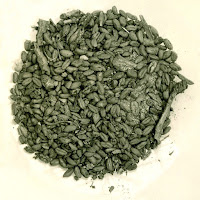 |
| Alabaster perfume jars from the tomb of Tutankhamun, (d. 1323 BC) |
Egyptian travertine (calcite) occurs in two varieties: (1) a nonbanded to faintly banded, tan to brownish-yellow, coarse- grained, translucent form; and (2) the strikingly banded form with interlayering of the first-mentioned variety with a white, fine- grained, opaque form. With prolonged exposure to sunlight, the brown and yellow colors become white. An example of this weathering phenomenon may be seen at the Mosque of Muhammad Ali (built from 1824 to 1848 CE) in Cairo's Citadel. Both the interior and exterior surfaces of this building were clad with banded travertine (calcite), but now the outside surface has become nearly white whereas the inside surface is still brightly colored.
Travertine (calcite) occurs as fracture-and-cavity fillings in the limestone deposits that border the Nile Valley between Esna in the south and Cairo in the north, and nine ancient quarries are known for this rock. The locations, from south to north, and the dates for these sites are the following: one site near Wadi Asyut (New Kingdom); four sites near the Tell el-Amama ruins at Hatnub (Old Kingdom through Roman period), both in and near Wadi el-Zebeida (Middle and New Kingdoms), and in Wadi Barshawi (possibly Middle Kingdom); one site at el-Qawatir near the city of el-Minya (possibly Old through New Kingdoms); one site in Wadi Umm Argub near the Wadis Muwathil and Sannur (Late period); one site in Wadi Araba near Wadi Askhar el-Qibli (Roman); and one site in Wadi el-Garawi near the city of Helwan (Old Kingdom). Banded travertine was obtained from all those quarries, but the nonbanded variety may have come only from Hatnub. (Hatnub is an ancient Egyptian word meaning "golden house," and it may have been applied to that quarry because of the uniform golden-brown color of its rock.).
As a relatively soft mineral (number 3 on the Mohs Hardness Scale), calcite is easily worked with bronze, copper, and other metal or stone tools. Its translucency, pleasing colors, and ability to take a fine polish made it a popular decorative stone in Egypt from early dynastic times onward. Because of the difficulty of obtaining large pieces, it was mainly employed for small objects, such as statuettes, shawabtis, offering tables, vases, bowls, dishes, canopic jars, and unguent jars. The unguent jars are the alabastra of classical Greece, originally ceramic and only later carved from Egyptian travertine (calcite), hence the Greco-Roman name alabastrites for this rock.
Occasionally, calcite was used for paving stones and wall linings in temples as, for example, in the fourth dynasty valley temple of Khafre at Giza and the nineteenth dynasty sanctuary in the temple of Ramesses II at Abydos, respectively. Although large travertine (calcite) objects are less common than small ones, many are known; these include sarcophagi, life-size and colossal statues, naoi, embalming beds, whole shrines, and other objects. One mode of transport for such articles was shown in a detailed painting on the wall of the twelfth dynasty tomb of Djehutihotpe (or Thuthotpe) at Bersheh, where a colossal statue of that nobleman is pulled on a sledge by 172 men. Some notable examples of large objects are the following:
(1) the sarcophagus of King Sety I from his tomb in the Valley of the Kings at Thebes, now in Sir John Soane's Museum, London; (2) two huge blocks at Kamak temple in Luxor—one a Late period offering stand or kiosk foundation in the Great Court and the other, possibly, a statue pedestal of uncertain age in the Central Court; (3) the colossal statue of the god Sobek with the eighteenth dynasty King Amenhotep III (1382-1344) from Dahamsha, now in the Luxor Museum; (4) the colossal statue of King Sety I from Karnak temple, now in the Egyptian Museum, Cairo; and (5) two bark shrines, one by the eighteenth dynasty kings Amenhotep I/Thutmose I, and one by the twelfth dynasty king Senwosret I, now in the open-air museum at Karnak temple. Numerous other examples may be found in Alfred Lucas, Ancient Egyptian Materials and Industries (1962).
Recent Pages:




